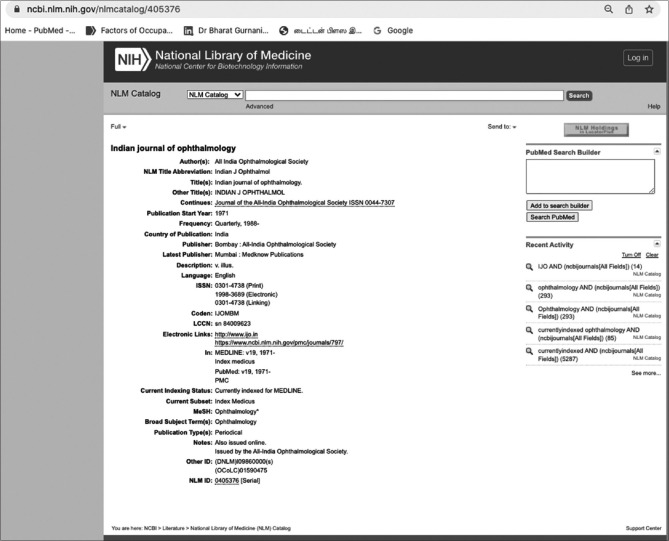Dear Editor,
The December 2021 issue of IJO highlighted important editorials,[1,2] original articles,[3] and expert comments[4,5] on the much neglected yet burning topic of predatory journals and predatory publishing, and we must congratulate all of the authors for giving a detailed insight into this topic. This will probably pave the way and spark more discussions on predatory publishing in the future issue of IJO. As residents, trainees, and early career researchers, we are unaware of the flip side of the coin. Here, we want to add a few more additional points on how to identify and protect ourselves from the ill effects of predatory publishing as an extension to our original article published in the December 2021 issue of IJO. This article is a definite add-on to the current predatory journals and publications literature.[3]
As young researchers and trainees, we must understand that it is unlikely that we will receive an invitation email for publication in a reputed journal. Invitations by reputable journals are usually to established authors who have done ample research work on a particular topic. Hence, any phishing mail from a journal, especially in the spam folder, should be labelled as predatory.
We must verify the publisher of the journal. Reputed publication teams are Elsevier, Springer, SAGE, Lippincott, Taylor & Francis, MedKnow, etc., to name a few. Any deviation from these should arouse suspicion and must be checked from the website of the predatory journal.
An important way to identify the biodata of a journal is by checking the details on the National Library of Medicine (NLM) catalog. There are a few predatory journals that are PubMed indexed, but not Medline indexed. Medline indexing is the most trusted way and gives a non-predatory identity to a journal. This can be quickly accessed at https://www.ncbi.nlm.nih.gov/nlmcatalog [Fig. 1].[6] Currently, 85 reputed non-predatory ophthalmology journals are indexed on Medline.
As early career researchers, our goal should be not to pay and publish. Few reputed authentic journals ask for article processing charges (APCs) only for colour images and open access, which is usually optional. The predatory journal usually asks for APCs even before publication and, in some instances, negotiate with the authors for APCs. This should make an author suspicious of the predatory nature of the journal.
Young researchers should go through Beall’s list, Cabell’s list, Manca’s list, and Strinzel’s list to make themselves aware of the predatory journal lists available.
Any assistance for medical writing or language correction should be avoided early in the career as it can easily become a habit and is labelled as gifted authorship.
Figure 1.
Digital grayscale image depicting the complete biodata of a journal giving intricate insights on the inception, frequency, country, publisher, language, ISSN, CODEN, MeSH, website link, current indexing, NLM ID, etc., Here, in the image given, is an example of the Indian Journal of Ophthalmology
Financial support and sponsorship
Nil.
Conflicts of interest
There are no conflicts of interest.
References
- 1.Bhagat PR. Predatory publications-Recognize and avoid. Indian J Ophthalmol. 2021;69:3387–8. doi: 10.4103/ijo.IJO_1943_21. [DOI] [PMC free article] [PubMed] [Google Scholar]
- 2.Ali MJ. Predatory journals and conferences:Analysis of invitation emails from a single clinician-scientist's inbox. Indian J Ophthalmol. 2021;69:3389–90. doi: 10.4103/ijo.IJO_2277_21. [DOI] [PMC free article] [PubMed] [Google Scholar]
- 3.Gurnani B, Kaur K. Avoiding predatory publishing for early-career ophthalmologists. Indian J Ophthalmol. 2021;69:3719–25. doi: 10.4103/ijo.IJO_1639_21. [DOI] [PMC free article] [PubMed] [Google Scholar]
- 4.Singh SR. Commentary:Publish or perish-Musings of a young faculty. Indian J Ophthalmol. 2021;69:3725–6. doi: 10.4103/ijo.IJO_2511_21. [DOI] [PMC free article] [PubMed] [Google Scholar]
- 5.Ali MJ. Commentary:Avoiding predatory publishing for early career ophthalmologists. Indian J Ophthalmol. 2021;69:3726–7. doi: 10.4103/ijo.IJO_1914_21. [DOI] [PMC free article] [PubMed] [Google Scholar]
- 6.NLM Catalog:Journal referenced in the NCBI Databases. [Last accessed on 2022 Apr 25]. Available from: https://www.ncbi.nlm.nih.gov/nlmcatalog/journals/



